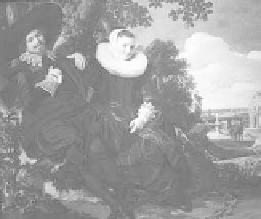Travel Reference
In-Depth Information
barflies, such as this one. He had to work quickly to capture the
serendipity of the moment. Hals used a stop-action technique,
freezing the man in mid-gesture, where the rough brushwork
creates a blur that suggests the man is still moving.
Two centuries later, the Impressionists learned from Hals'
messy brushwork. In the Van Gogh Museum, you'll see how Van
Gogh painted, say, a brown beard by using thick dabs of green,
yellow, and red that blend at a distance to make brown.
Frans Hals—
Wedding Portrait of Isaac Abrahamsz Massa
and Beatrix van der Laen
(1622)
his wedding portrait of a chubby, pleasant merchant and his bride
sums up the story of the Golden Age. Because this overseas trader
was away from home for years at a
time on business, Hals makes a special
effort to point out his patron's com-
mitment to marriage. Isaac pledges
allegiance to his wife, putting his
hand on his heart. Beatrix's wedding
ring is prominently displayed dead
center between them (on her right-
hand forefinger, Protestant-style). The
vine clinging to a tree is a symbol of
man's support and woman's dependence. And in the distance at
right, in the classical love garden, are other happy couples strolling
arm-in-arm amid peacocks, a symbol of fertility.
In earlier times, marriage portraits put the man and wife in
separate canvases, staring out grimly. Hals' jolly couple reflects a
societal shift from marriage as business partnership to an arrange-
ment that's more friendly and intimate.
Hals didn't need symbolism to tell us that these two are
prepared for their long-distance relationship—they seem relaxed
together, but they each look at us directly, with a strong, individual
identity. Good as gold, these are the type of people who propelled
this soggy little country into its glorious Golden Age.
Various Still Lifes (c. 1630)
Savor the fruits of Holland's rich overseas trade—lemons from the
south, pitchers from Germany, and spices from Asia, including
those most exotic of spices...salt and pepper. These carefully com-
posed, photo-realistic still lifes reflect the same sense of pride the
Dutch have for their homes, cultivating them like gardens until
they're immaculate, decorative, and well-ordered.
Pick one, such as
Still Life with Gilt Goblet
(by Willem Claesz
Heda, 1635). Get so close that the guard joins you. Linger over




















